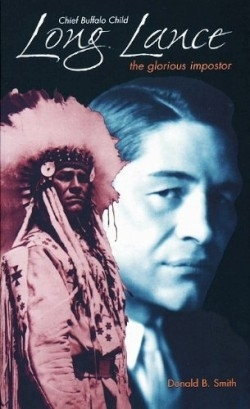Chief Buffalo Child Long Lance
The Glorious Imposter
In the late 1920s, a Blackfoot Indian chief from Montana caused a sensation in New York society’s upper-echelon. The dark, ruggedly handsome man who spoke flawless English was a celebrity in his own right—West Point man, World War I veteran, journalist, lecturer and movie star. Writes Smith: “The affluent, upper-class Americans of Park Avenue felt a certain shame and guilt about the plight of the Indian, whose land was stolen, whose numbers were receding to the vanishing point and who posed no threat to real estate values.” Imagine their mortification when the rumor spread that Long Lance was, in actuality, a man of color.
His real name was Sylvester Long, born in 1890 in Winston-Salem, North Carolina, but he wasn’t African-American. His ancestry was white and Indian—frontiersman Kit Carson had been a distant relative—but because of the family’s coloring, they were classified as “colored” and subject to the South’s segregation laws.
As a child, Long couldn’t understand this. “His parents and his brothers explained how Sylvester must show respect for the white folks, but this only confused him. His mother, his brothers and many of his relatives all looked like white folks.”
The opportunity to create a new identity for himself first arose when he attended the Carlisle Indian School in Pennsylvania where future Olympic athlete Jim Thorpe was a close classmate.
Smith, a professor of Canadian history at the University of Calgary, became interested in the Long Lance saga after picking up a copy of Lance’s 1928 self-titled autobiography at a secondhand bookstore and noticed inconsistencies. His quest for answers led to researching Long’s life, which resulted in this book, first published nearly twenty years ago.
Smith traces his subject from France (where he saw action in the war) to Canada, where Long worked as a journalist covering the First Nation (Indians) member tribes. He stuck close to the facts, but his personal life became more fiction.
Always embedded in the layers were kernels of truth. Smith explains that’s why later acquaintances could be so easily deceived; the man from Winston-Salem was also friendly and gregarious.
Long’s fictional life began to unravel at the start of his acting career when producers undertook a background check. Long’s death in 1932—classified a suicide—was shrouded in mystery. It seems only appropriate for a man who lived his life that way, too.
Reviewed by
Robin Farrell Edmunds
Disclosure: This article is not an endorsement, but a review. The publisher of this book provided free copies of the book to have their book reviewed by a professional reviewer. No fee was paid by the publisher for this review. Foreword Reviews only recommends books that we love. Foreword Magazine, Inc. is disclosing this in accordance with the Federal Trade Commission’s 16 CFR, Part 255.

